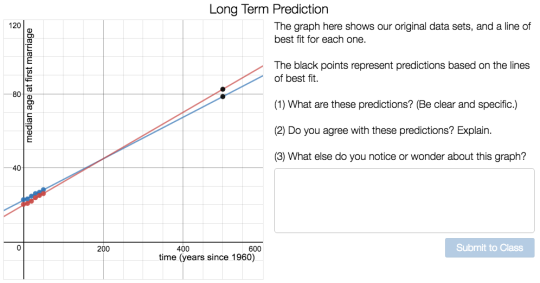In our most recent fellow’s prompt, we asked the fellows to compare
Lego Prices
and
Are People Waiting to Get Married?. Our discussion highlighted values and unique perspectives, helping us to
develop common ideas around what makes a good Desmos activity. Many of the
fellows highlighted elements of the
Desmos guide for building activities
as they compared the activities, while others focused on the objective and how
their students would relate to each context.
Incorporates a Variety of Nouns and Verbs
-
Heather Kohn,
Linda Saeta, and
Paul Jorgens noticed that both
activities incorporate a variety of nouns and verbs. Over the course of each
activity students are asked to predict, sketch, build a model, use an
equation or graph to answer questions about the context, interpret
parameters, and to reflect on their thinking.
Create Problematic Activities
-
Bob Lochel acknowledges that both
activities allow students to connect representations effectively, but thinks
that Lego Prices does a better job of developing need to connect the data
and graph to an algebraic expression. Using the computation layer then
personalizes the experience for students, builds informal practice, and
allows students to take ownership of next steps.
-
Nathan Kraft also comments on
the way that Lego Prices connects student thinking throughout the activity
with a central problem, and notices the absence of this in Are People
Waiting to Get Married?. “We really did something with those initial guesses
[in Lego Prices] thanks to the computation layer. With Marriage, we’re
asked to guess a median age in 2010, but then that never really comes up
again, unless the student remembered this question from slide 1 and feels
like checking the graphs. As I was going through the activity, I
wasn’t sure what the focus was (slope? intercepts? systems? linear vs.
non-linear?)”
-
Anna Scholl and Paul
Jorgens also note the lack of a clear problem in Are People Waiting to Get
Married?, with Paul offering some ideas for how to improve the frame for the
activity. “I don’t feel connected to the prediction in the opening
screen. Maybe I need to be asked how old I think I will be when I get
married. Maybe we can see a median of our class data and then look at some
trends of real data. Perhaps a better opening question might be to ask about
the speculate on the typical age for someone to get married.” Thanks
Paul!
-
Michael Fenton offers
his perspective
on how Lego Prices does a better job with creating problematic
activities.
Create Cognitive Conflict
Though Lego Prices may do a better job of framing a central problem, we still have lots of love for Are People Waiting to Get Married?, which ends with this particularly compelling screen.

-
Nick Corley and Linda Saeta
notice that extrapolation on the last screen of Are People Waiting to Get
Married? drives home lots of cognitive conflict.
-
Dan Anderson notes that “I liked
how the Marriage activity talked about the danger of extrapolation while the
Lego activity extrapolation NAILED the prediction for the Death Star. Both
are valuable lessons. The Lego extrapolation is nice because it works, and
the Marriage extrapolation is nice because it doesn’t work.”
Instructional Goals
-
Anna Scholl points to the differences in prequisite knowledge for both
activities, and that they each seem to have different instructional goals.
Knowing the standards for the courses that you teach as well as how those
standards progress throughout courses can help in determining such
subtleties.
-
Heather Kohn reminds us that choosing between these activities depends on
what we want students to do mathematically. In Lego Prices students will
build a model with draggable points. They’ll use an automatically generated
graph and equation to answer questions about the context. Are People Waiting
to Get Married? asks students to build a model by hand, and use that model
to answer questions. Both models are linear, but the skill involved is quite
different.
- Nick Corley, Linda Saeta, and Dan Anderson find that Lego Prices might be suitable for students in middle school both due to the y-intercept being zero and the model being built by a draggable line.
What do you consider when choosing activities? Let us know on Twitter
@desmos.
